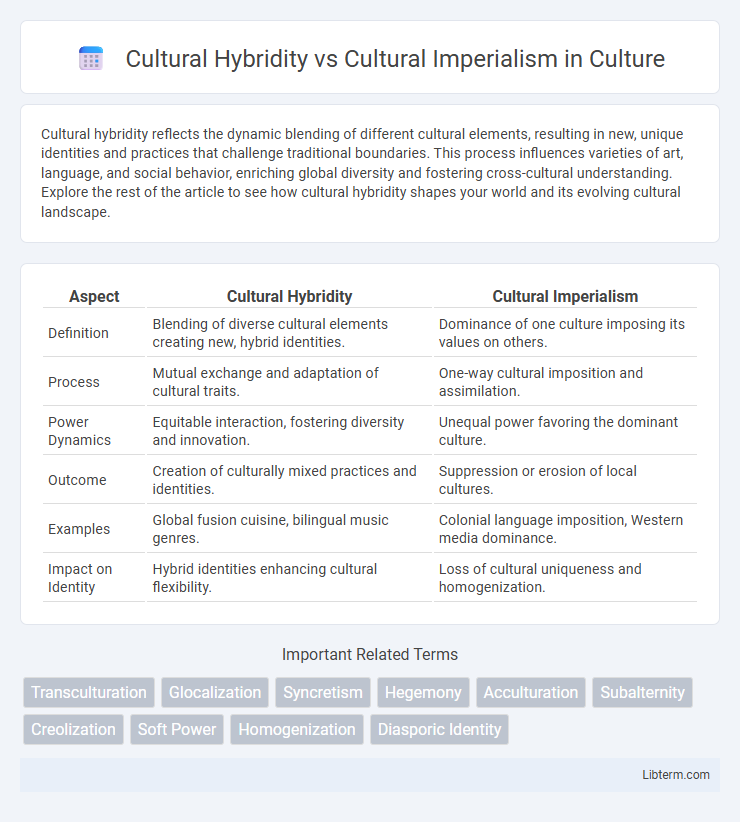Cultural hybridity reflects the dynamic blending of different cultural elements, resulting in new, unique identities and practices that challenge traditional boundaries. This process influences varieties of art, language, and social behavior, enriching global diversity and fostering cross-cultural understanding. Explore the rest of the article to see how cultural hybridity shapes your world and its evolving cultural landscape.
Table of Comparison
| Aspect | Cultural Hybridity | Cultural Imperialism |
|---|---|---|
| Definition | Blending of diverse cultural elements creating new, hybrid identities. | Dominance of one culture imposing its values on others. |
| Process | Mutual exchange and adaptation of cultural traits. | One-way cultural imposition and assimilation. |
| Power Dynamics | Equitable interaction, fostering diversity and innovation. | Unequal power favoring the dominant culture. |
| Outcome | Creation of culturally mixed practices and identities. | Suppression or erosion of local cultures. |
| Examples | Global fusion cuisine, bilingual music genres. | Colonial language imposition, Western media dominance. |
| Impact on Identity | Hybrid identities enhancing cultural flexibility. | Loss of cultural uniqueness and homogenization. |
Understanding Cultural Hybridity: Definition and Origins
Cultural hybridity refers to the process by which elements from different cultures merge to create new, dynamic cultural forms, emerging primarily from postcolonial contexts where diverse cultural interactions occur. This concept originates from the works of theorists like Homi K. Bhabha, who emphasized the fluidity of cultural identities and the spaces of negotiation between dominant and marginalized cultures. Understanding cultural hybridity involves recognizing the complex blending and adaptation that challenge static notions of pure cultural identity in globalized societies.
The Concept of Cultural Imperialism Explained
Cultural imperialism refers to the dominance of one culture over others, often through media, language, and consumer products, leading to the erosion of local cultures and identities. This concept highlights the power imbalance where dominant cultures impose their values and norms, resulting in homogenization and cultural dependency. Critics argue that cultural imperialism undermines cultural diversity by promoting a monoculture aligned with global economic and political interests.
Key Differences Between Hybridity and Imperialism
Cultural hybridity involves the blending of two or more distinct cultures, resulting in new, dynamic cultural forms that promote mutual exchange and creativity. Cultural imperialism refers to the dominance of one culture over others, often leading to the erosion or suppression of indigenous cultural identities. The key difference lies in hybridity's emphasis on reciprocal influence and transformation, while imperialism centers on power imbalance and cultural domination.
Historical Examples of Cultural Hybridity
Historical examples of cultural hybridity include the Mughal Empire in India, where Persian, Indian, and Islamic influences merged to create a unique architectural and artistic style. The African diaspora in the Americas produced Afro-Caribbean cultures blending African traditions with European and Indigenous elements. The Silk Road facilitated cultural exchanges between East and West, resulting in hybrid art forms, religious practices, and technological innovations.
Case Studies of Cultural Imperialism in Modern History
Case studies of cultural imperialism in modern history highlight the imposition of dominant cultures through colonization, such as the British Empire's spread of English language and Western education in India, which marginalized indigenous traditions. The Americanization phenomenon, characterized by the global diffusion of U.S. media, consumer brands, and cultural values, exemplifies economic and cultural dominance impacting local cultures worldwide. These cases reveal power asymmetries where dominant cultures suppress or reshape subordinate cultural identities, contrasting with cultural hybridity that emphasizes blending and mutual influence without coercion.
The Role of Globalization in Shaping Cultures
Globalization accelerates cultural hybridity by facilitating the exchange and fusion of diverse traditions, languages, and practices across borders, resulting in dynamic, multi-layered cultural identities. It simultaneously enables cultural imperialism, where dominant cultures, often driven by economically and politically powerful nations, impose their values and norms on less dominant societies, leading to cultural homogenization or erasure. The global flow of media, consumer goods, and technology plays a critical role in both promoting hybrid cultural expressions and reinforcing power imbalances in cultural representation and influence.
Effects of Cultural Hybridity on Identity and Society
Cultural hybridity shapes identity by blending diverse traditions, resulting in dynamic and multifaceted social identities that challenge rigid cultural boundaries. It fosters creativity and innovation within societies by merging different cultural expressions, contributing to social cohesion through increased mutual understanding. However, cultural hybridity can also provoke tensions as individuals navigate between global influences and local traditions, affecting social norms and community structures.
Consequences of Cultural Imperialism on Local Traditions
Cultural imperialism often leads to the erosion of local traditions as dominant cultures impose their values, languages, and practices, causing indigenous customs to be marginalized or lost. This process can diminish cultural diversity and weaken social cohesion within communities by prioritizing homogenized cultural norms. The economic and political power behind cultural imperialism frequently accelerates the commodification of local cultures, reducing rich traditions to mere tourist attractions or commercial products.
Media Influence: Spreading Hybridity and Imperialism
Media plays a pivotal role in spreading cultural hybridity by blending diverse cultural elements through global films, music, and digital platforms, fostering cross-cultural exchanges and new hybrid identities. Conversely, media can also perpetuate cultural imperialism by dominating local cultures with Western-centric narratives, advertising, and content, often marginalizing indigenous voices and traditions. The dynamic interplay between cultural hybridity and imperialism in media highlights the power structures influencing which cultural expressions gain visibility and influence worldwide.
Navigating the Future: Balancing Cultural Exchange and Preservation
Navigating the future of cultural exchange requires a delicate balance between cultural hybridity and cultural imperialism, where the fusion of diverse traditions fosters innovation without erasing indigenous identities. Emphasizing the preservation of local customs alongside global influences ensures sustainable cultural diversity and mutual respect among societies. Strategic policies promoting equitable cultural dialogue and protecting minority heritage are essential to maintain this equilibrium in an increasingly interconnected world.
Cultural Hybridity Infographic

 libterm.com
libterm.com